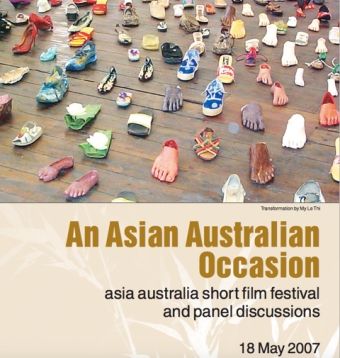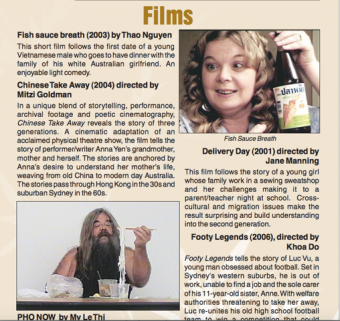
An Asian Australian Occasion
There is so much to celebrate about what the Asian Australian community has achieved over the past ten years.
There are many memorable individuals who have pioneered and maintained a space for all types of collaborations and productions to stand under the umbrella term ‘Asian Australian’, and to reach a broader public. This includes high profile public figures, grassroots community workers, filmmakers, book authors, bloggers and YouTube content creators, activists, academics, artists and performers and more. Many also move easily across these categories, passionately tapping into many forums and media. They create much richness and insight into our vast community experiences, hopes, and imaginations.
It was in 2007 that I worked on my first Asian Australian event. I chaired a mini film festival and series of panel talks called ‘An Asian Australian Occasion’. Tseen Khoo, one of the founders of the AASRN, was a wonderful mentor in getting this AA event going, and she continues to play that role for me and many others. The organising committee included Colin Fung, Alan Han, Benjamin Law, Daniel Tang, Jen Tsen Kwok, Belle Uy, Jessica Wells and Ben Cho.
Four of us went on from being university students to having PhDs, while others have made their mark in the arts, as authors, and in activism. At the time of ‘An Asian Australian Occasion’, though, we were all just driven individuals living on instant noodles and chasing every avenue we could for funding and ‘mates rates’ to hold a great event.
With my heart on my sleeve and about two hours sleep a night, I worked hard on getting sponsorship and funding, which resulted in an Equity Office Diversity Week Grant and other material support. We did all this because seeing Asian faces on the screen was something we felt was lacking and we believed it was important to see our society’s diversity onscreen, not just for Asian Australians but for the broader public, too. We wanted a more accurate picture of who we are as a nation.
Back then, Ben Law, who was one of the panel speakers and is now quickly becoming a household name, was a typically broke uni student working on a script (which would eventually become a book, then Australia’s first TV series featuring an Asian Australian cast, The Family Law). The panels also featured Alan Han, David Ip, Jacqueline Lo, and Anna Yen. They each offered insights into Asian Australian histories and their experiences and reflections on their academic and artistic endeavours.

The mini film festival showed productions by Khoa Do (a former Young Australian of the Year), Carine Chai, Ngay Giao, Mitzi Goldman, Thao Nguyen, and visual artist My Le Thi. These shows included actors like Anh Do, Simon Chan, and Anna Yen.
The event, while small scale, was well received and created the momentum for the 2011 Asian Australian film and panel event. This 2011 project spurred on the formation of the Asian Australian Film Forum and Network (AAFFN) that is co-convened by Amadeo Marquez-Perez, Sukhmani Khorana, and myself. The AAFFN has featured speakers such as Annette Shun Wah, Maria Tran, Alfredo Nicdao, Chris Pang, Joy Hopwood, Corrie Chen, Suzanne Qian, P.J. Madam, Jiao Chen, Jane Park, and Yu Ye Wu, to name a few. It has also brought attention to films by Khoa Do, Heng Tan, Minh ‘Minty’ Tran, Somchay Phakonkham, Michael Chin, Pearl Tan, Dominic Golding, Sophie Bli, Quan Tran, Jack Ngu, Hoang Tran Nguyen, David Cuong Nguyen and more.
The event was featured in a special issue of Peril the following year. The AAFFN continues to keep promoting Asian Australian faces on and behind the screen today via formal and ‘pop up’ events, an interview series (including with Lawrence Leung, Andy Trieu, Thien Nguyen, Maya Newell, John Green, Matthew Victor Pastor, Khanh Trieu, Charlotte Nicdao) and social media. In 2017, it will be the tenth anniversary of the Asian Australian Occasion event.
In Australia, we love reaching a decade’s worth of milestones, not just for organisations like the AASRN and entities like Peril, but also for individuals. With the exception of the cheeky 21st birthday outlier, all our big party, party, party celebrations are reserved for 10th, 20th, 30th, and so on anniversaries and birthdays. That’s when we know there’s going to be ‘fancy’ party food and, hopefully, free bevvies on tap.
So, in this special Peril issue, a bit of hearty celebration is warranted for a decade’s worth of progress and achievements for the AASRN, Peril, and the Asian Australian community. We can certainly permit ourselves a bit of a pat on the back and a beer (or bubble tea or, um, even water…name your poison).
This is a time not just for reflection and evaluation on how far we’ve come, but also to consider where we might go in the new decade.
We come from many shores, local and overseas. We have a rich tapestry in terms of our combined cultural heritages, class backgrounds, language/s, interests, passions and work paths. Given such diversity, and in efforts not to fall into false biological beliefs about categories of nationality, ‘race’ and ethnicity, it can become difficult to think about what unites us.
Questions of identity are complex things. This should excite us because identities are non-essentialist and open-ended, defying neat definitions. They are a mixture of self-identification and community recognition. What is most important are the reasons at the heart of embracing the term or using it to refer to others. These reasons can influence whether the usage of identity terms is empowering, or its opposite.
In this short article, the term Asian Australian has been embraced as a way to refer to an identity and community that is beautifully complicated. It is a rich collection of physical, cultural, social, historical and geographic variations that, combine to create a connection with being both ‘Asian’ and ‘Australian’.
The trick is to never allow the simplification of the category of Asian Australian. We need to ensure that it’s an identity and community that allows for complexities and flexibilities in purpose and presentation. With such openness, may the new decade begin!

